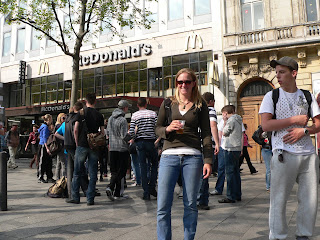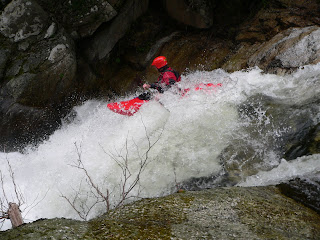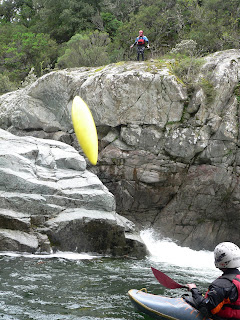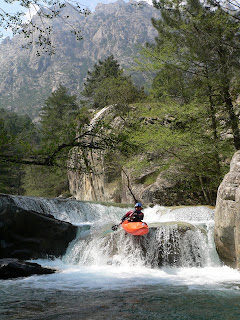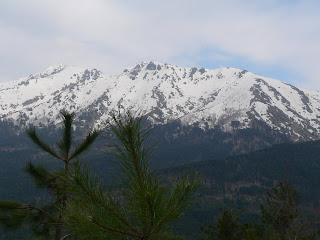When most people arrive in France they probably learn how to say important French phrases like "Où sont les toilettes s'il vous plaît?" (Where are the toilets please?) and "J'ai besoin d'un taxi" (I need a taxi). My first French words were “Giclée a gauche” and “Giclée a droite,” which mean "boof left" and "boof right." These two phrases became my lifeline throughout the 12 days I spent kayaking on the French island of Corsica.
The Corsica kayaking season takes place exclusively in April, when the combination of snow melt and rain provide enough water in the rivers to make them runnable. Because of this, many view the trip to Corsica as a pilgrimage of sorts and it is evident why when you see the island taken over by Euro vans stacked high with kayaks.
My trip to Corsica was made possible by a French friend and fellow kayaker Antoine Dupuis who I met years ago on a boating to Ecuador. We remained in contact after leaving Ecuador and this past March he sent me an email inviting me to join him on his annual trip to Corsica. Initially I did not even know where Corsica was, but after looking at some pictures from his previous trips I decided it was an opportunity I could not pass up.
I flew into Paris and immediately caught a train to Lyon, where I met Antoine who was arriving in from three weeks in Chile. From there we took a bus ride back to his home in Grenoble and spent the next morning loading up the van and preparing for our trip to Corsica. After a five hour drive to the Port town of Toulon, we loaded up on the ferry and began our 10 hour journey across the Mediterrean.
While waiting to board the ferry we met another group of French boaters and spent the evening drinking beer and eating bread, cheese and dried sausage. Little did I know at the time that that would become my diet for the next two weeks. Eventually it was time for bed and we all laid out on the floor of the ferry and slept peacefully beneath the shining halogen lights.
The Corsica kayaking season takes place exclusively in April, when the combination of snow melt and rain provide enough water in the rivers to make them runnable. Because of this, many view the trip to Corsica as a pilgrimage of sorts and it is evident why when you see the island taken over by Euro vans stacked high with kayaks.
My trip to Corsica was made possible by a French friend and fellow kayaker Antoine Dupuis who I met years ago on a boating to Ecuador. We remained in contact after leaving Ecuador and this past March he sent me an email inviting me to join him on his annual trip to Corsica. Initially I did not even know where Corsica was, but after looking at some pictures from his previous trips I decided it was an opportunity I could not pass up.
I flew into Paris and immediately caught a train to Lyon, where I met Antoine who was arriving in from three weeks in Chile. From there we took a bus ride back to his home in Grenoble and spent the next morning loading up the van and preparing for our trip to Corsica. After a five hour drive to the Port town of Toulon, we loaded up on the ferry and began our 10 hour journey across the Mediterrean.
While waiting to board the ferry we met another group of French boaters and spent the evening drinking beer and eating bread, cheese and dried sausage. Little did I know at the time that that would become my diet for the next two weeks. Eventually it was time for bed and we all laid out on the floor of the ferry and slept peacefully beneath the shining halogen lights.
 Boarding the ferry
Boarding the ferryAfter landing in the Corsican city of Bastia, we had a quick breakfast by the sea and were off to our first river of the trip, the Fium Orbo. The drive to the river was pretty amazing in itself and I was immediatley blown away by the scenery on the island. With a beautiful coastline and jagged snow capped peaks, this place seemed to have it all.
My first Corsican river started off with a nice 15 or so foot drop called "The Rocket" and was followed quickly with my first Corsican portage. The rest of the run included lots of fun class 4-5 rapids and left me excited for what was to come.
My first Corsican river started off with a nice 15 or so foot drop called "The Rocket" and was followed quickly with my first Corsican portage. The rest of the run included lots of fun class 4-5 rapids and left me excited for what was to come.
 The "Double Drop" rapid
The "Double Drop" rapidAfter finishing the Fium Orbo, Antoine and I drove to the Travo river, where we would join up with another group and get ready for a big adventure on the Haut Travo (Upper Travo) the following morning.
The Upper Travo is actually forbidden to be paddled due to access issues with the small village you must pass to get there. Because of this, we had to wake up at 5am to start the day in order to drive through the village before daylight. We were already starting the hour long hike in as the sun was rising and we were putting on the river by 8am.
The river was filled with non-stop class 5 clean beautiful rapids. With two 25-30 footers and more 15 footers than I could count, this truly is a classic section of whitewater. Because of the amount of vertical drops involved in the run, we had to scout and set safety for most of the rapids which makes for a long time on the water. There is also an hour long, very difficult portage in the middle of the run which can definitely wear you down. The portage trail was pretty much non-existent because this section of river generally only gets done once a year by a small group of people. The other portage to note is the 30 foot jump in which scared me personally more than any of the rapids out there (I have a fear, not of heights, but of jumping in the water from high; I would much rather run a 30 foot waterfall in my boat than jump in without it)
It was on this run that I met JC, who is a French paddler and one of the main people responsible for pioneering the Upper Travo run. I felt fortunate to have him along on the trip down the river as well as as one of my main paddling partners throughout the rest of my trip.
The Upper Travo is actually forbidden to be paddled due to access issues with the small village you must pass to get there. Because of this, we had to wake up at 5am to start the day in order to drive through the village before daylight. We were already starting the hour long hike in as the sun was rising and we were putting on the river by 8am.
The river was filled with non-stop class 5 clean beautiful rapids. With two 25-30 footers and more 15 footers than I could count, this truly is a classic section of whitewater. Because of the amount of vertical drops involved in the run, we had to scout and set safety for most of the rapids which makes for a long time on the water. There is also an hour long, very difficult portage in the middle of the run which can definitely wear you down. The portage trail was pretty much non-existent because this section of river generally only gets done once a year by a small group of people. The other portage to note is the 30 foot jump in which scared me personally more than any of the rapids out there (I have a fear, not of heights, but of jumping in the water from high; I would much rather run a 30 foot waterfall in my boat than jump in without it)
It was on this run that I met JC, who is a French paddler and one of the main people responsible for pioneering the Upper Travo run. I felt fortunate to have him along on the trip down the river as well as as one of my main paddling partners throughout the rest of my trip.
 Setting safety at one of the harder rapids
Setting safety at one of the harder rapidsWe took off the river later that aternoon and I was thrilled to have just had the opportunity to do such an amazing run. I was told that this was the best section of river on the island, and I was fortunate enough to do it on only my second day. After basking in the 70 degree sunny weather at the camp spot for a few hours, we all went to celebrate our adventure on the river by drinking beers in a local hot spring bath followed by a private party at a local bar. Apparently it has become tradition to visit this bar after every successful run of the Upper Travo and my French companions were sure to continue this tradition.
The next morning the group loaded up and drove over the mountains to paddle the Upper Rizzanese. Second only to the Upper Travo, this section of river was on the top of my list of the best rivers in Corsica. It involved class 4 and 5 rapids back to back and left me always on my toes. (My camera battery died during the run so I unfortunately don't have many pictures of this section)
The river starts off with a tight 25 foot waterfall which is backed up by a 30 foot cave. Antoine was the first to decide to run the drop and ended up getting stuck in the hole/ on the wall at the bottom. The French safety setting technique (which involves setting up a tethered swimmer at any significant rapid) came in handy on this rapid and the "diver" (the person hooked up the rope) jumped into the water and managed to grab Antoine and pull him out. Antoine's boat however was not so lucky and ended up getting pulled in behind the veil into the cave. We ended up having to lower him into the water and have him crawl back into the cave behind the drop to retrieve his boat. It took two attempts and about an hours time for the boat extraction to be successful. It was at this moment that I decided to put my boat on my shoulder and carry around the drop.
The next morning the group loaded up and drove over the mountains to paddle the Upper Rizzanese. Second only to the Upper Travo, this section of river was on the top of my list of the best rivers in Corsica. It involved class 4 and 5 rapids back to back and left me always on my toes. (My camera battery died during the run so I unfortunately don't have many pictures of this section)
The river starts off with a tight 25 foot waterfall which is backed up by a 30 foot cave. Antoine was the first to decide to run the drop and ended up getting stuck in the hole/ on the wall at the bottom. The French safety setting technique (which involves setting up a tethered swimmer at any significant rapid) came in handy on this rapid and the "diver" (the person hooked up the rope) jumped into the water and managed to grab Antoine and pull him out. Antoine's boat however was not so lucky and ended up getting pulled in behind the veil into the cave. We ended up having to lower him into the water and have him crawl back into the cave behind the drop to retrieve his boat. It took two attempts and about an hours time for the boat extraction to be successful. It was at this moment that I decided to put my boat on my shoulder and carry around the drop.
 JC on one of the many great rapids of this section
JC on one of the many great rapids of this sectionThe following day we joined up with another group of Antoine's friends to do the Codi river, a tributary to the Rizzanese. The river was very narrow and somewhat manky at times but still lots of fun.
 Antoine was the only one who decided to run this drop because we all thought it was too manky- turned out it was in fact too manky
Antoine was the only one who decided to run this drop because we all thought it was too manky- turned out it was in fact too manky The last rapids and a great viewpoint of the run
The last rapids and a great viewpoint of the runBecause the group that we were now paddling with had just arrived and missed out on our trip to the Upper Travo a couple days earlier, they decided to head that way to paddle it the next morning. I was a little apprehensive about going again so soon because I knew of what a tiring day it is and I was a bit sore from my previous four days of boating, but after a little bit of wine and a little bit of reflecting on the picture perfect rapids, I could not pass up an opportunity to go back. So that next morning, Antoine, JC and I woke up to get our second run of the Upper Travo that year. I was able to get a couple different viewpoints for pictures to supplement the ones I took on my first trip down.
And in order to keep with tradition we followed up our run with another party at the local bar. It turned out to be quite an awesome evening due to the locals who were having their own party compete with guitarists playing songs in the Corsican language.
And in order to keep with tradition we followed up our run with another party at the local bar. It turned out to be quite an awesome evening due to the locals who were having their own party compete with guitarists playing songs in the Corsican language.
 JC's van packed with boats (this way no one could tell we were kayakers as we drove through the village that forbids us to be on the river)
JC's van packed with boats (this way no one could tell we were kayakers as we drove through the village that forbids us to be on the river) JC running the biggest drop on the river which involves a boof into a 10 foot slide into a 25 foot drop
JC running the biggest drop on the river which involves a boof into a 10 foot slide into a 25 foot drop Breakfast in the field next to the bar
Breakfast in the field next to the barThe next day we decided to take it easy and paddled the Gorge du Tavignano section, a class 3-4 run that while lacking in hard rapids, made up for it with amazing scenery.
 A classic post-river lunch: wine, cheese, sausage and baguettes- we ate like this literally everyday after getting off the river
A classic post-river lunch: wine, cheese, sausage and baguettes- we ate like this literally everyday after getting off the riverAfter a night of camping at the Corisca River Festival campground, we took off for the Restonica river. The Restonica is known to be one of the more continuous and steep rivers on the island. The water was clearer than ever and the tall rocky mountains surrounding the run made it one of the most beautiful ones we did.
After having our daily dose of cheese and bread, we drove over mountain pass in order to get to the Foium Grosso which we paddled the next day. Unfortunately the day on the Fium Grosso was a not so pretty day weather wise and consequently I did not take many pictures. Weather aside the day was great and had lots of fun class 5 drops in between innumerous class 4 ones.
 Antoine running a hard sketchy rapid that I don't really think had a clean line (he was the only one to attempt it)
Antoine running a hard sketchy rapid that I don't really think had a clean line (he was the only one to attempt it)Everyone in the group decided that is was time to hit the beach after taking off the river, and so off we went to the nearby west coast town of Porto to camp by the sea. I was completely blown away by the scenery here and took the afternoon to drive around the coast taking it all in.
 Our camping spot by the sea
Our camping spot by the seaWaking up in the sunshine by the beach was great, and while part of me could have stayed there for days, it was time to get back on the water for another day of boating. This time we were off to the Calasina, one of the higher altitude runs we did. The water was a bit too low (reminded me of creeking in the south east during the drought) but the views of snow capped peaks all the way down made it a bit more bearable.
After the beating my body took on the low water Calasina run, I finally decided I was ready for a day off. Antoine and I headed back to the coast, this time the more sandy east coast. While the weather did not exactly cooperate with us, we still managed to have a wonderful afternoon on the beach.
 Antoine on the rocks after taking a cold swim (I decided not to partake)
Antoine on the rocks after taking a cold swim (I decided not to partake)The following morning we were back at the Rizzanese, this time to paddle the classic section. This was a special day for the Rizzanese as it was an organized event for the Corsica River Festival in order to bring everyone together to fight the daming of this Corsican classic. Like the upper, this section starts off with a very technical class 5 waterfall which only a handful of boaters ran. The first person to go pinned and broke his paddle, so everyone was a bit apprehensive.
Immediately after the waterfall, the locals who are also fighting to stop the building of the dam had layed out a beautiful spread of food and wine for the boaters. It was quite an event and I don't know if I have ever had such a friendly welcoming on a river before. After taking pictures as a huge group to use as a resource to show support for the cause, Antoine and I took off downstream in order to avoid paddling with such a large group. The river had lots of great rapids, including one very nice 30 foot waterfall.
Immediately after the waterfall, the locals who are also fighting to stop the building of the dam had layed out a beautiful spread of food and wine for the boaters. It was quite an event and I don't know if I have ever had such a friendly welcoming on a river before. After taking pictures as a huge group to use as a resource to show support for the cause, Antoine and I took off downstream in order to avoid paddling with such a large group. The river had lots of great rapids, including one very nice 30 foot waterfall.
 Me running the waterfall
Me running the waterfallFrom the Rizzanese we drove back over the mountain towards to the Travo river, this time to do the Classic section. I was sad to know that this would be my final day of boating in Corsica, but happy to have gotten to do so much during such a short time on the island.
The Classic Travo included a granite gorge with lots of very picturesque rapids. I tried to take in every moment I could on the river knowing that in just a few hours I would be back on the ferry heading towards mainland France.
The Classic Travo included a granite gorge with lots of very picturesque rapids. I tried to take in every moment I could on the river knowing that in just a few hours I would be back on the ferry heading towards mainland France.
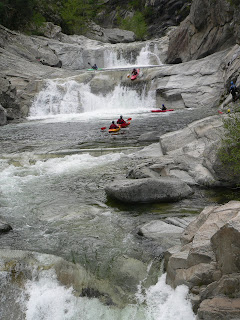 Me running the second drop of the triple drop rapid
Me running the second drop of the triple drop rapidLater that evening, Antoine dropped me off at the port to catch my long ferry back to the mainland. After arriving the next morning I quickly hopped a train to Paris and spent that afternoon exploring the city before heading back to the US the next day.
 The Notre Dame Cathedral
The Notre Dame CathedralOne of the nicknames for Corisca is "The Island of Beauty" and I cannot tell you how perfect a name that is. I felt like everytime I turned my head there was a new landscape, jagged mountain or sandy beach. That alongside the epic kayaking found there in April makes it a trip of a lifetime and one that I will not soon forget.

